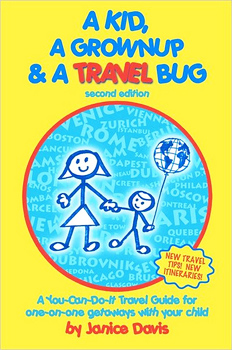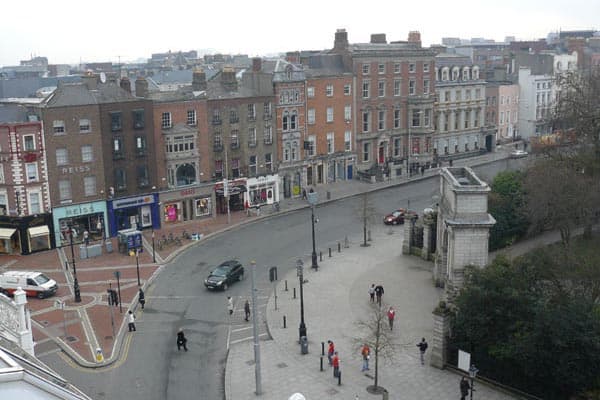Travel Fun for the Family: A Kid, A Grownup & A Travel Bug by Janice Davis
By Helena Wahlstrom

Janice Davis admits she’s no travel expert — just a mom who loves to travel with her kids — but her book, A Kid, A Grownup & A Travel Bug is nonetheless a warmhearted and practical guide into making the most of traveling with kids, with a hefty dose of information for almost any type of traveler.
“A Kid, A Grown Up & A Travel Bug focuses on one-to-one travel with a child, and was a result of my taking an impromptu trip with my daughter when she was six years old. On this trip I realized that one-on-one travel with a child was such an amazing bonding experience that I wanted to share the idea,” Davis explains on her .
Divided into two parts, the second edition of this book explains the how and the why of travel with kids, including topics like the value of travel and organizing the best possible trip.
After that, Davis explains the where, with sample itineraries into Europe and the United States. As it is based on her own experiences, the advice in this book is best suited for small families on short trips.
Among the helpful tips, Davis sprinkles stories from her own family’s travels as well as cute pictures of her children in various locations. Although her kids are now grown, A Kid, A Grownup & A Travel Bug contains several years’ worth of accumulated travel experience, sure to provide an entertaining read and a few helpful tips for anyone interested in taking their kids along for the next trip.
An excerpt from the book: Reserving Ahead – Or Not (Hotels)
Now that my kids are no longer very young, when the whole family is together on long vacations we sometimes “wing it” and find our hotel when we arrive at our destination. This enables us to pick and choose what we like, in a building we find charming, on a street that’s convenient and pretty.
It’s a little risky in terms of finding the city booked up, but we’ve never yet found ourselves without a place to sleep. More than once we’ve would up with a splendid room that we never could have afforded had we booked ahead but, since it was vacant and unlikely to be rented for its full value at the last minute, we were given it for the same price as the smaller less spectacular rooms.
Since your one-on-one trip will be only for a few days, however, it’s not wise to waste precious time by having to wander around looking for a place to stay, so booking in advance in that case becomes wiser.
First and foremost: Beware the package deal!!! While I certainly would not say that they are rip-offs in all cases, you must carefully check to make sure that the hotel that’s part of the deal is really in a part of town where you’d want to be.
You can be sure that you will be booked into a large hotel, which either means it will be lovely but much more expensive than necessary, or, too often on the more “reasonably” priced packages, it will be characterless or (worse!) not centrally located.
The way to go for your small family unit is a small family-run hotel, more accurately known as a bed-and-breakfast (England), pensione (Italy), albergo (Italy or Spain) or auberge (France), or whatever this translates into the language of the country to which you’re headed.
While this type of accommodation is cropping up here and there in some American cities (there [are] about four or five that I know of in my area of Brooklyn), they are far from the norm. In the U.S. we associate the term “Bed and Breakfast” with Victorian houses in the mountains or small beach towns, not urban environments.
Most Americans who haven’t traveled abroad (or have only stayed in large hotels when traveling abroad) have not experienced the charm, warmth and personality of staying in small family-run hotels in the center of a city (with the exception of New Orleans where these types of accommodations do seem to uniquely prosper).
In Europe, however, such hotels exist in great abundance in every city.
While their reasonable room rates might be what draws you to them originally, you’ll find that frugality is far from the only reason to stay in such a place.

For one thing, you will in the great majority of cases be staying in a house, integral to the city, with a few hundred years of its own history, as opposed to the new construction of the box-like rooms of a modern hotel.
How much easier it is, then, to immediately feel immersed in that history, and therefore to feel like you’re a part of it and living it, and not like an outside observer in a characterless observation-tank of a room!
The other wonderful thing about a B&B is that, as part of the (relatively minimal) cost of your room, your breakfast is included. I don’t say that this is “wonderful” because of the few pennies you save on not having to buy your own morning coffee, but because breakfast is provided in a breakfast room, where you are surrounded by almost-always friendly fellow-travelers.
Unlike a restaurant or coffee shop in a chain hotel, the breakfast room has the ambiance of a place where your host has invited all his/her guests to share a meal together. You’ll meet fascinating people from all over the world, invariably including a few other Americans and also other children.
While you don’t want to be in the constant company of an organized group, that’s not to say that you don’t ever want the company of other people at all – breakfast at a B&B is a chance to exchange stories and experiences with other families having their own adventures, parallel to yours.
The honeymoon couple from Amsterdam might be able to tell you about a fabulous little restaurant they found the night before. The woman visiting from Osaka might be eager to tell you that, although the museum you’re planning to visit is wonderful, her child loved another one so much more.
A simple breakfast becomes another chance to underscore the idea that people from all corners of the globe see our world as a wonderful place that’s theirs to explore, getting to know each other in the process.
How will you know how to recognize this type of accommodation? For one thing as you read down the guidebook listings you might look for the above terminology (‘auberge’ or ‘pensione’ instead of ‘hotel’), as well as the number of rooms (obviously if the number of rooms is 140 you can assume it is not a small B&B).
What you’re looking for is a “one star” or “two star” accommodation. Americans often refer to luxury hotels as “five star” or “four star”, but we don’t tend to monitor smaller hotels on this “star” system. Europeans, however, definitely do.
If a hotel has no stars at all, that is significant to note – avoid these, unless you are able to make the stretch that falling plaster, mildewed carpet and questionably washed sheets with holes in them further reflect that “sense of history” we were just discussing…
Another aspect of one-star hotels that is very common and taken for granted in much of the world, but that Americans are often taken a-back by, is that the toilet and shower may be down the hall from your room and therefore shared by the guests from several other rooms. This might have a negative connotation to Americans simply because it’s not something we ever see at home in a hotel we’d consider decent.
Before rejecting the idea out-of-hand, though, give some thought to the fact that the custom of a shared bathroom is not seen as a mark of a seedy or disreputable place outside of this country. If you think about it, when you are a guest in your Cousin Sally’s home you don’t generally have your own bathroom, but have to share it with Sally’s other guests. It’s not usually a terrible hardship in that situation and it doesn’t have to be in this case either, and it may be a way for you to save a significant amount of money.
- Japan: Touring the Temple - March 4, 2014
- Best Budget Carry-on Luggage for Travel: Top 6 - June 17, 2012
- Many Ways to See Rome: Walking, Biking, Vespa, Bus and Boat - June 1, 2012




